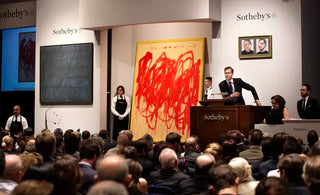
The art world has become much more accessible in recent years, with collectors able to buy artworks through galleries, fairs, advisory services, online platforms – and one of the most exciting formats of all: art auctions.
Auction sales make up roughly 20% of annual art sales, making them a highly popular option for art collectors around the world.
Whether you’re an aspiring investor or simply curious, this guide explains how art auctions work and what to expect, from registration and bidding to insider lingo.
What is An Art Auction?
Before we delve into the ins and outs of art auctions, let’s discuss the basics. An auction house is a place where property and objects are sold to the highest bidder. There are auction houses for a range of industries, from real estate to art.
At art auctions, you can purchase a variety of different artworks. Some art auctions involve only luxury art and masterworks, whereas others may include art from blue-chip and red-chip artists.
An art auction is essentially a public event, where people from all backgrounds come together to bid on pieces of art. That being said, some auctions are exclusive and only a select few are able to participate.
The three major auction houses are Christie’s, Phillips and Sotheby’s - at these auction houses, you can purchase fine art and masterworks from the likes of Leonardo da Vinci, Picasso, and many more.
How Do Art Auctions Work?

Once you have arrived at the auction house, you will be given a brief preview of the products on sale at the auction.
The auctioneer will also explain the conditions of each piece. Read on to find out what to expect from an art auction, from registration to bidding.
Step 1: Register With The Auctioneer
Once you have previewed the art on auction, you need to register to bid with the auctioneer. You’ll need to provide personal information such as your address, phone number, and proof of identity. Some auctions will require photographic ID such as your passport or driver’s licence.
Upon registration, you will be given a number card. This card allows you to be identified during the auction.
Step 2: Listen to The Host
Next, the auction will begin in the auction room. You will hear the sound of a bell - this indicates the beginning of the auction. You’ll then listen to the host talk about the items available - the host will describe each item to you and the other bidders.
Step 3: Bid on Pieces You Like
Now you’re getting to the fun part of art auctions - the bidding. The auctioneer will announce the minimum price, and the bidders will raise their paddle to call their bid. Each bid needs to be higher than the previous one - the auctioneer will discuss this beforehand.
The bidding ends when the final bidder makes their bid. The auctioneer’s hammer will come down, and the item will then belong to the final bidder.
You will be given a warning before the hammer goes down, giving you a chance to exceed the previous bid. If you are the highest bidder and win the item, you’ll pay what you offered (as well as additional costs such as buyer’s premium) and then take it home with you.
Online Art Auctions

Art auctions can also take place online – a popular and growing format that makes collecting art more accessible than ever. Whether hosted through established auction houses or digital-first platforms, online auctions allow you to take part from anywhere in the world.
The process is similar to a live auction:
-
You'll register in advance and may need to verify your ID.
-
Bidding usually takes place via timed events or live-streamed video feeds with real-time interaction.
-
You’ll place bids by clicking buttons or entering amounts, with minimum bid increments enforced just like in physical auctions.
However, there are a few things to keep in mind. For example, it's harder to assess an artwork’s texture, colour accuracy, and size from images alone. Reputable auction houses often provide condition reports, high-resolution images, or even virtual previews to help mitigate this.
Also, online auctions can attract global attention, meaning more bidders for sought-after pieces. Still, online art auctions can be a great entry point for new collectors, especially if you're seeking convenience or looking to explore a wider selection of art.
Art Auction Lingo To Learn
Although you may be familiar with many terms used in an art auction, some terms may be more difficult to understand. Below, we are going to outline the definitions of some terms you may hear in an art auction.
-
Appraisal - an evaluation of the market value of a piece of art. A valuations team will often compare a piece of art with similar works that have been recently sold. The appraisal will typically determine the presale auction estimate.
-
Bid Increment - the amount that each bid is increased by. Often, auctioneers will set the bid increment as 10% - meaning that each bid should be around 10% higher than the previous bid.
-
Fair warning - the warning given by the auctioneer that the hammer is about to come down. This gives attendees a final chance to increase their bids.
-
Hammer Price - the hammer price refers to the winning bid at an auction. The auctioneer’s hammer will fall to determine the sale price. The hammer price, however, does not include the buyer’s premium. The auctioneer’s hammer is also known as a ‘gavel’.
-
Paddle - when you attend an auction, you will be given a paddle. You raise the paddle to place a bid. The auctioneer will record your paddle number if you win the auction.
-
Provenance - this applies to the art authentication process, referring to the chain of ownership since the piece of art was created. The provenance of a piece of art can influence its overall value.
Where Else Can I Buy Art?
Many people choose to invest in art they find at art fairs. Art fairs can include a wide range of art from both new and emerging artists as well as prominent industry names and blue-chip artists. Check out this blog to learn more about blue-chip art.
Art galleries are a great place to purchase art. You can purchase art to add to your art collection at our very own Grove Gallery in London.
At Grove Gallery, we are home to an expert art advisory service. We understand that the art market isn’t always easy to navigate - especially if you are a beginner. This is why our team of art advisors can guide you through the process.
Explore our collection of originals today, or check out our limited edition art prints.






